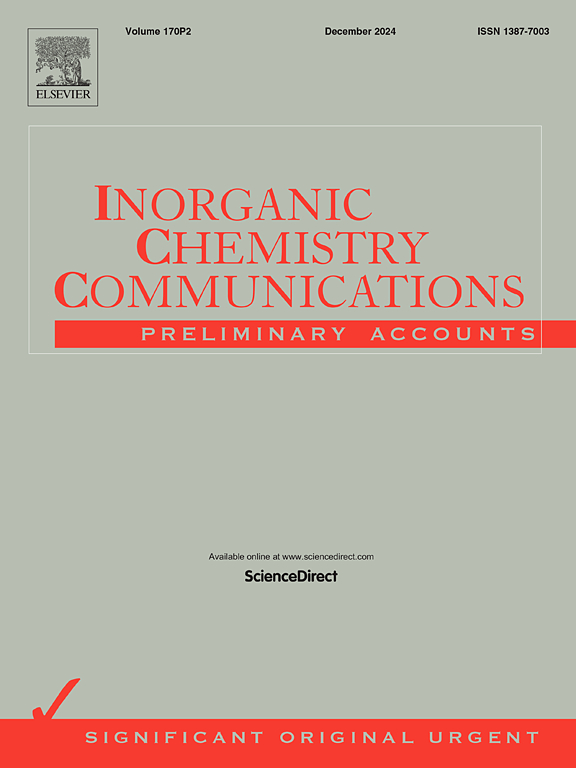Synthesis of two new Sn (IV) carboxylate complexes: Crystal structures, density functional theory and Hirshfeld surface analysis computation, antibacterial, antifungal, and bioinformatics potential determination
IF 4.4
3区 化学
Q1 CHEMISTRY, INORGANIC & NUCLEAR
引用次数: 0
Abstract
The current study presents two novel organotin (IV) carboxylate complexes, namely C1 [NNNH-SnPh3]) and C2 ([SCCO-SnBu2]4). C1 and C2 have been produced utilizing L1 [4-(((3,5-dimethyl-1H-pyrazol-1-yl) methyl) amino) benzoic acid] and L2 [(E)-3-(thiophen-2-yl) acrylic acid] as pro-ligands with carboxylic acid functionalities. The desired complexes were characterized via NMR and FT-IR spectroscopy and single crystal X-ray diffraction for the 3D structure. The ligands and their complexes were analyzed for their structural properties using HF, B3LYP and M062X/6-31 + G(d,p) computational methods. Moreover, to support the crystallographic results, complex C1 was subjected to Hirshfeld surface analysis. Furthermore, the antibacterial and antifungal properties of both C1 and C2, as well as free L1 and L2, were examined. We have examined and enhanced several characteristics, such as physicochemical qualities, toxicity hazards, and optimal structures, using bioinformatics calculations. Subsequently, the molecular interactions with target proteins, specifically the structure of Pseudomonas aeruginosa (PDB ID: 2UV0) and the structure of Escherichia coli (PDB ID: 4PRV), were analyzed to explain their experimental activities.
两种新型锡(IV)羧酸盐配合物的合成:晶体结构、密度泛函理论和Hirshfeld表面分析计算、抗菌、抗真菌和生物信息学潜力测定
本研究提出了两种新的有机锡(IV)羧酸盐配合物,即C1 [NNNH-SnPh3])和C2 ([SCCO-SnBu2]4)。C1和C2是用L1[4-((3,5-二甲基- 1h -吡唑-1-酰基)甲基)氨基苯甲酸]和L2 [(E)-3-(噻吩-2-酰基)丙烯酸]作为羧酸官能团的前配体制备的。通过核磁共振、红外光谱和单晶x射线衍射对所需要的配合物进行了三维结构表征。采用HF、B3LYP和M062X/6-31 + G(d,p)计算方法分析配体及其配合物的结构性质。此外,为了支持晶体学结果,对配合物C1进行了Hirshfeld表面分析。此外,还检测了C1和C2以及游离L1和L2的抗菌和抗真菌性能。我们已经检查和增强了几个特征,如物理化学性质,毒性危害,和最佳结构,使用生物信息学计算。随后,分析了与靶蛋白的分子相互作用,特别是铜绿假单胞菌(PDB ID: 2UV0)和大肠杆菌(PDB ID: 4PRV)的结构,以解释它们的实验活性。
本文章由计算机程序翻译,如有差异,请以英文原文为准。
求助全文
约1分钟内获得全文
求助全文
来源期刊

Inorganic Chemistry Communications
化学-无机化学与核化学
CiteScore
5.50
自引率
7.90%
发文量
1013
审稿时长
53 days
期刊介绍:
Launched in January 1998, Inorganic Chemistry Communications is an international journal dedicated to the rapid publication of short communications in the major areas of inorganic, organometallic and supramolecular chemistry. Topics include synthetic and reaction chemistry, kinetics and mechanisms of reactions, bioinorganic chemistry, photochemistry and the use of metal and organometallic compounds in stoichiometric and catalytic synthesis or organic compounds.
 求助内容:
求助内容: 应助结果提醒方式:
应助结果提醒方式:


